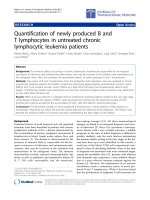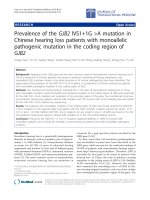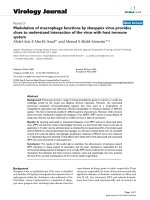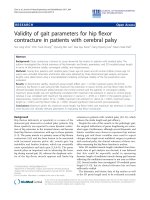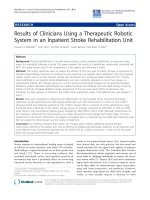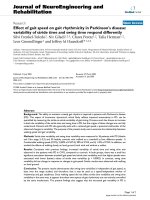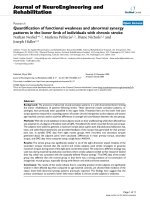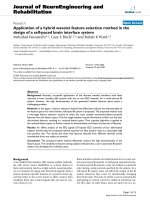báo cáo hóa học: " Modulation of walking speed by changing optic flow in persons with stroke" ppt
Bạn đang xem bản rút gọn của tài liệu. Xem và tải ngay bản đầy đủ của tài liệu tại đây (580.37 KB, 8 trang )
BioMed Central
Page 1 of 8
(page number not for citation purposes)
Journal of NeuroEngineering and
Rehabilitation
Open Access
Research
Modulation of walking speed by changing optic flow in persons with
stroke
Anouk Lamontagne*
1
, Joyce Fung
1
, Bradford J McFadyen
2
and
Jocelyn Faubert
3
Address:
1
School of Physical and Occupational Therapy, McGill University and Jewish Rehabilitation Hospital Research Center (CRIR), Montreal,
Canada,
2
Department of Rehabilitation, Laval University, and Quebec Rehabilitation Research Institute (CIRRIS), Quebec, Canada and
3
Vision
and Perception Laboratory, School of Optometry, University of Montreal, Montreal, Canada
Email: Anouk Lamontagne* - ; Joyce Fung - ;
Bradford J McFadyen - ; Jocelyn Faubert -
* Corresponding author
Abstract
Background: Walking speed, which is often reduced after stroke, can be influenced by the perception of optic
flow (OF) speed. The present study aims to: 1) compare the modulation of walking speed in response to OF speed
changes between persons with stroke and healthy controls and 2) investigate whether virtual environments (VE)
manipulating OF speed can be used to promote volitional changes in walking speed post stroke.
Methods: Twelve persons with stroke and 12 healthy individuals walked on a self-paced treadmill while viewing
a virtual corridor in a helmet-mounted display. Two experiments were carried out on the same day. In
experiment 1, the speed of an expanding OF was varied sinusoidally at 0.017 Hz (sine duration = 60 s), from 0 to
2 times the subject's comfortable walking speed, for a total duration of 5 minutes. In experiment 2, subjects were
exposed to expanding OFs at discrete speeds that ranged from 0.25 to 2 times their comfortable speed. Each test
trial was paired with a control trial performed at comfortable speed with matching OF. For each of the test trials,
subjects were instructed to walk the distance within the same time as during the immediately preceding control
trial. VEs were controlled by the CAREN-2 system (Motek). Instantaneous changes in gait speed (experiment 1)
and the ratio of speed changes in the test trial over the control trial (experiment 2) were contrasted between the
two groups of subjects.
Results: When OF speed was changing continuously (experiment 1), an out-of-phase modulation was observed
in the gait speed of healthy subjects, such that slower OFs induced faster walking speeds, and vice versa. Persons
with stroke displayed weaker (p < 0.05, T-test) correlation coefficients between gait speed and OF speed, due to
less pronounced changes and an altered phasing of gait speed modulation. When OF speed was manipulated
discretely (experiment 2), a negative linear relationship was generally observed between the test-control ratio of
gait speed and OF speed in healthy and stroke individuals. The slope of this relationship was similar between the
stroke and healthy groups (p > 0.05, T-test).
Conclusion: Stroke affects the modulation of gait speed in response to changes in the perception of movement
through different OF speeds. Nevertheless, the preservation of even a modest modulation enabled the persons
with stroke to increase walking speed when presented with slower OFs. Manipulation of OF speed using virtual
reality technology could be implemented in a gait rehabilitation intervention to promote faster walking speeds
after stroke.
Published: 26 June 2007
Journal of NeuroEngineering and Rehabilitation 2007, 4:22 doi:10.1186/1743-0003-4-22
Received: 18 January 2007
Accepted: 26 June 2007
This article is available from: />© 2007 Lamontagne et al; licensee BioMed Central Ltd.
This is an Open Access article distributed under the terms of the Creative Commons Attribution License ( />),
which permits unrestricted use, distribution, and reproduction in any medium, provided the original work is properly cited.
Journal of NeuroEngineering and Rehabilitation 2007, 4:22 />Page 2 of 8
(page number not for citation purposes)
Background
Regulation of walking involves the integration of visual,
proprioceptive and vestibular information. Optic flow
(OF) is a typical pattern of visual motion generated at the
eye as the person moves through the environment [1]. OF
is a source of visual information that can be used to con-
trol heading direction [2-4] and speed [5-8] of walking, as
it provides information about the direction and speed of
self-motion with respect to the environment. Studies in
healthy individuals have shown that changing OF speed
modulates walking speed while walking on a self-paced
treadmill [6-9]. During walking, visual (OF) and proprio-
ceptive information about self-motion are normally con-
gruent. When OF speed is manipulated in such way that it
mismatches the proprioceptive information from the legs,
walking velocity is adjusted to reduce the incongruity. The
strategy adopted by healthy subjects is to reduce their
walking speed with an increasing speed of OF, and to
increase their speed at slower OFs [6,7]. This adaptation
has been shown to be altered by neurodegenerative dis-
eases such as Parkinson's disease [10], in which the heavy
reliance on visual [11] and kinesthetic information would
produce exaggerated gait speed modulation responses.
Slow speed, a feature that characterizes locomotion after
stroke [12], can impact on functional ability such as cross-
ing a street within the time allotted by the pedestrian light.
It is well accepted that muscle weakness, particularly on
the paretic lower limb, is one of the main factors explain-
ing slow gait speed after stroke [13,14]. When motivated
and instructed to walk at faster speeds, however, subjects
with stroke have the capacity to at least double their walk-
ing speed [15], suggesting that factors other than muscle
weakness may be contributing. It has also been shown
that the discrimination of direction of global motion is
altered by stroke, even when the primary cortical visual
areas are preserved [16,17]. Whether similar deficits in
discriminating OF speed exist in this population is yet to
be determined. The present study is based on the premise
that an altered perception or integration of OF speed
information could contribute to the difficulty of subjects
with stroke in regulating walking speed. A residual ability
to utilize OF to control the speed of walking, however,
would provide the basis for gait intervention with virtual
reality that manipulates OF parameters to enhance walk-
ing ability after stroke.
The specific aims of this study were: first, to compare the
non-volitional modulation of walking speed in response
to an OF of variable speed between persons with stroke
and healthy controls and second, to investigate whether a
virtual reality-based paradigm that manipulates OF speed
could be used to promote volitional changes in walking
speed in persons with stroke. We hypothesized that per-
sons with stroke, although presenting with an altered
modulation of walking speed in response to OFs of chang-
ing speed, would still present sufficient modulation such
that a paradigm based on OF speed manipulation could
be used to promote faster walking speeds.
Methods
Subjects
Twelve subjects with a hemiparesis (9 males/3 females)
due to a first-time stroke in the middle cerebral artery
region and twelve healthy controls (8 males/4 females)
participated in this study (Table 1). The location of the
stroke was confirmed by computerized tomography or
magnetic resonance imaging. Subjects with stroke pre-
sented with mobility problems, as they were ambulating
at a walking speed slower than 1 m/s, with or without
walking aid. They had no visual field defect, as assessed by
the optometrist using the Goldman Test or equivalent
measure. All but 2 were free of visuospatial neglect (sub-
jects S3 and S4), as assessed by the Bell's test [18] or Star
Cancellation Test [19]. As those 2 subjects did not behave
differently from the others, their data were pooled
together with the other subjects with stroke for analysis.
Any subject with orthopaedic or another neurological
condition that could interfere with locomotion was
excluded. All subjects signed an informed consent docu-
ment and the project was approved by the Montreal
Center for Interdisciplinary Research in Rehabilitation
(CRIR).
Set-up and Procedures
Subjects were evaluated while walking on a self-paced
treadmill and watching, in a head mounted display
(HMD), virtual environments representing corridors (Fig-
ure 1). The HMD (Kaiser Optics ProView™ XL50) has a
field of view of 50° diagonal, 30° vertical by 40° horizon-
tal. The self-paced treadmill allows one to modify walking
speed at will, by servo-controlling the motor with a real-
time algorithm that takes into account the pelvis position
in the anteroposterior direction, as measured by a poten-
tiometer tethered to the subject, and the walking speed.
The self-paced treadmill was equipped with bilateral slid-
ing handrails, which allowed arm swing and anteroposte-
rior displacements of the body while assisting with
balance maintenance during walking. A safety harness sys-
tem suspended overhead prevented the subjects from fall-
ing.
Subjects were first habituated to walk on the self-paced
treadmill without the HMD, and then with the HMD
while watching a virtual corridor scene expanding at a
speed matching their comfortable walking speed. Com-
fortable walking speed was determined after a minimum
of 4 to 5 minutes of habituation while walking with the
HMD. Subjects listened to white and pink noises through
earphones during testing, to avoid any speed feedback
Journal of NeuroEngineering and Rehabilitation 2007, 4:22 />Page 3 of 8
(page number not for citation purposes)
from auditory cues. White noise has equal energy at all fre-
quencies, while pink noise has more power in the lower
frequencies that the higher frequencies. The latter pro-
vides additional masking power for low frequency noises.
Two series of experiments were conducted on the same
day, with experiment 2 following experiment 1. Because
of fatigue or time constraint, one healthy control and 3
subjects with stroke did not complete experiment 2. In the
first experiment, the instantaneous and non-volitional
changes in walking speed in response to an OF of contin-
ually changing speed (Experiment 1) were examined. In
the second, the voluntary or intentional changes in walk-
ing speed in response to OFs at discrete constant speeds
(Experiment 2) were examined. In Experiment 1, the speed
of an expanding OF was varied sinusoidally (0.017 Hz, 1
sine duration = 60 s), from 0 to 2 times the individual's
comfortable walking speed, for a total duration of 5 min-
utes. The sine wave was preceded and ended by 30 sec-
onds of OF matching comfortable speed. In Experiment 2,
subjects were instructed to walk at a comfortable pace
(control trials) on the self-paced treadmill through a 13
m-long virtual corridor comprising of 2 doorways located
10 m apart. Subjects started walking 1.5 m before the first
door and ended at 1.5 m after the second door when a
stop sign appeared. Every control trial was followed by a
test speed trial, during which expanding OFs correspond-
ing to 0.25, 0.5, 0.75, 1.00, 1.25, 1.50, 1.75 and 2 times
the individual's comfortable speed were randomly pre-
sented. For each test speed trial, subjects were instructed
to cover the corridor distance within the same time span
as the previous control trial.
Distance travelled and walking speed were provided by
the treadmill tachometer and recorded at 100 Hz using
the Caren-2
®
system (Motek) that also manipulated the
OF speeds. In addition, the treadmill speed signal was
recorded at 360 Hz using the Vicon-512 A-D system.
Speed signals were low-pass filtered at 0.02 Hz (second-
order Butterworth, dual pass for zero lag).
Data Analysis
For Experiment 1, the strength of the relationship and
phase lag between the OF speed and walking speed signals
were analyzed by means of cross-correlations. For Experi-
ment 2, the mean walking speed over the 10 m separating
the 2 doorways was calculated for every trial. Changes in
walking speed for the speed trials were expressed as a ratio
of the mean walking speed in the test trial over the control
trial (gait speed ratio). The slopes between gait and OF
speed ratios were obtained using linear regressions. All
outcome variables, including cross-correlation coeffi-
cients, phase lags and slopes were compared between sub-
jects with stroke and healthy controls using Student t-tests
for independent samples. The relationship of these varia-
bles with the subjects' comfortable gait speeds was also
quantified using Pearson correlation coefficients. Statisti-
cal analyses were carried out in Statistica 7.0
®
and the level
of significance was set p < 0.05.
Results
Experiment 1
Examples of modulation of walking speed in response to
an OF of continually changing speed are illustrated for a
healthy subject and subjects with stroke in Figure 2. In
Table 1: Subject Characteristics
Stroke (n = 12) Age (yrs) Gender (/M) Height (cm) Weight (Kg) Speed (m/s) Side
(R/L)
Time Stroke
(mo)
Location CVA
S1 50 M 173 75 0.80 R 3.4 Sylvian L
S2 79 M 176 73 0.35 (Cane) L 27.7 Subcortical R
S3 71 M 178 72 0.15 (Quad*) R 14.0 Sylvian L
S4 66 M 152 68 0.18 (Quad) L 19.0 Sylvian R
S5 73 155 48 0.3 (Cane) R 2.9 Sylvian L
S6 79 M 152 60 0.60 (2 Canes) R 2.1 Sylvian L
S7 64 M 172 90 0.15 (Quad) R 1.5 Sylvian L
S8 51 M 185 96 0.66 L 51.6 Sylvian R
S9 73 154 90 0.34 R 1.0 Sylvian L
S10 68 M 162 50 0.25 (Cane) L 3.2 Sylvian R
S11 80 M 172 70 0.12(Quad) L 2.1 Sylvian R
S12 67 180 88 0.85 L 3 Sylvian R
Mean 68.4 - 168 73 0.40 - 11 -
Range 50–80 - 152–180 48–96 0.12–0.85 1.0–51.6 -
Controls
(n = 12)
Mean 63.5 - 169 79 1.12 - - -
Range 50–74 - 152–185 63–104 0.81–1.67 - - -
Journal of NeuroEngineering and Rehabilitation 2007, 4:22 />Page 4 of 8
(page number not for citation purposes)
healthy subjects, gait speed was modulated out-of-phase
with respect to OF speed, such that faster walking speeds
were observed at slower OFs, and slower walking speeds
at faster OFs. Subjects with stroke presented either with
less modulation or changes in walking speed (Figure 2B),
or patterns of modulation that varied from out-of-phase
to in-phase (Figure 2C). On average, cross-correlation
analyses revealed negative correlation coefficients
between gait speed and OF speed for both groups (Figure
3). The strength of this relationship, however, was weaker
(p < 0.05) in subjects with stroke than in healthy controls.
Similar phase lags were observed in both groups, with a
speed response lagging behind the changes in OF speed by
5.1 s and 4.8 s, respectively, in the healthy and stroke
groups. Neither the cross-correlation coefficients (R
2
=
0.08, P = 0.4) nor the phase lags (R
2
= 0.08, P = 0.4) were
associated with the comfortable overground walking
speed post stroke.
Modulation of gait speed (dotted lines) as a function of optic flow speed (plain lines) in a healthy subject (A) and subjects with stroke presenting with a slow (B) and a faster walking speed (C)Figure 2
Modulation of gait speed (dotted lines) as a function of optic
flow speed (plain lines) in a healthy subject (A) and subjects
with stroke presenting with a slow (B) and a faster walking
speed (C). Data were analyzed once the subjects reached
their comfortable speed, as indicated by the vertical dashed
lines. Left and right y-axes are for optic flow speed and gait
speed, respectively. Note the different y-axis scales amongst
the subjects.
Virtual corridors used for Experiment 1 (A) and Experiment 2 (B)Figure 1
Virtual corridors used for Experiment 1 (A) and Experiment
2 (B). The scene represented in (A) is adapted from the
library of VRCO Inc.
Journal of NeuroEngineering and Rehabilitation 2007, 4:22 />Page 5 of 8
(page number not for citation purposes)
Experiment 2
Figure 4 represents examples of changes in walking speed
as a function of changes in OF speed, as measured during
Experiment 2. In healthy subjects and subjects with
stroke, a negative linear relationship was generally
observed between gait speed and OF speed, such that sub-
jects walked faster at slower OFs. The gain of this relation-
ship, as quantified by the slope between gait speed ratio
vs. OF speed ratio, was similar between subjects with
stroke and healthy controls (p > 0.05) (Figure 5). On aver-
age, the highest increments in speed observed at slow OFs
reached 1.32 ± 0.25 and 1.44 ± 0.38 times comfortable
gait speed values, respectively, in the healthy and stroke
groups. Subjects with stroke who walked at slower com-
fortable speeds displayed steeper modulation slopes (R
2
=
0.53, p < 0.05) and higher ratios of speed increment (R
2
=
0.78, p < 0.05) than those who walked at faster initial
speeds.
Discussion and Conclusions
The purpose of this study was to investigate the ability of
persons with stroke to modulate their speed of walking in
response to changing OF speeds. The main findings are
that subjects with stroke present with alterations in their
Changes in gait speed as a function of changes in optic flow speed in a healthy subject (A) and subjects with stroke pre-senting with a slow (B) and fast (C) walking speedFigure 4
Changes in gait speed as a function of changes in optic flow
speed in a healthy subject (A) and subjects with stroke pre-
senting with a slow (B) and fast (C) walking speed. Both gait
speed and optic flow speed were expressed as ratios of the
actual speed observed in the test trial as compared to con-
trol trial with matching gait and OF speeds.
Mean cross-correlation coefficients (A) and phase lags (B) calculated between gait speed and optic flow speed in the healthy subjects and subjects with strokeFigure 3
Mean cross-correlation coefficients (A) and phase lags (B)
calculated between gait speed and optic flow speed in the
healthy subjects and subjects with stroke.
Journal of NeuroEngineering and Rehabilitation 2007, 4:22 />Page 6 of 8
(page number not for citation purposes)
speed modulation response to changing OF speeds. How-
ever, when instructed to use OF speed information to
scale their walking speed, they display patterns of modu-
lation that are similar to those observed in age-matched
healthy subjects.
Results of the present study demonstrate that walking
speed is modulated out-of-phase with OF speed in
healthy subjects, which is consistent with previous studies
[6-8], despite the fact that expanding OFs were simulated
by a meaningful and rich virtual environment in the
present study. Previous research used gratings composed
of dots, spots or diamonds oscillating to form contracting
and expanding OFs [6-8]. The observed non-volitional
changes in gait speed induced by changes in OF speed in
our healthy age-matched controls, although consistent,
were of small magnitude. According to Varraine and col-
laborators [8], this consistency combined with the fact
that OF speed variations are not fully compensated by
changes in gait speed, would argue in favor of a 'low level
phenomenon' that is not under voluntary control. Present
findings also revealed that gait speed responses were lag-
ging behind the changes in OF speed. Such a lag may be
explained by the latency of OF perception added to the
latency for the mechanical transformation of the segmen-
tal kinematics.
Results from Experiment 2, in which subjects voluntarily
attempted to walk a fixed distance within the same time
span while exposed to OFs of different speeds, yielded
larger walking speed changes than when exposed to the
sinusoidally changing OF speeds in Experiment 1. This
difference was observed despite the fact that the range of
OF speed was smaller in Experiment 2 (0.25 to 2 times the
individual's comfortable speed) than during Experiment 1
(0 to 2 times). The larger modulation observed in Experi-
ment 2 may be attributed to the fact that information
from constant OF speeds is easier to perceive and integrate
than continually changing speeds, while a cognitive inten-
tional process was also involved. The fact that the walking
distance was shorter and that perception of time (duration
required to walk the hallway) may have been a useful
source of information to complete the task may also have
contributed to the larger gait speed modulation responses
observed in the second experiment. Gait speed adaptation
did not fully compensate the mismatch with OF speed,
even by our healthy aged-matched subjects, as indicated
by slope values that did not approach -1.0. This partial
compensation suggests the involvement of other sensori-
motor transformations based on an internal representa-
tion and the central nervous system's integration of other
sensory cues, such as leg proprioceptive information.
Present results also showed that subjects with stroke dis-
played abnormalities in their non-volitional or uninten-
tional modulation of walking speed. Both animals [20-
22] and human studies [23-26] suggest that optic flow
perception involves not only the occipital, but also pari-
etal and temporal cortical areas. Overall, as the complex-
ity of the stimulus increases (first vs. second order
stimuli), increasing neural networks involving more ante-
rior brain regions are recruited [27-29]. Persons with a
stroke in the temporal lobe or in adjacent regions of the
frontal or parietal lobes manifest abnormally high thresh-
olds for the discrimination of global motion direction
[17]. Whether they also present with higher discrimina-
tion thresholds for optic flow speed is still unclear. We
have also shown that subjects with stroke present with a
difficulty in integrating multiple sensory information,
such as those induced during a rapid voluntary head turn
while standing or walking [30,31]. The altered modula-
tion response observed in the subjects with stroke could
thus be explained by an altered discrimination of OF
speed and/or a reduced ability to integrate multiple
sources of sensory information.
It is also noteworthy that the down-regulation response
observed in the subjects with stroke differs from the up-
regulation response observed in subjects with Parkinson's
disease, which manifests as an abnormally large modula-
tion in walking speed in response to changing OF speed
[10]. This finding in Parkinson's disease was interpreted
as a higher reliance on visual kinesthesia, possibly due to
an altered proprioceptive guidance of movement (propri-
oceptive kinesthesia). In the present study, none of our
subjects with stroke showed abnormally large responses,
which could suggest that they do not rely on visual
kinesthesia as much as in Parkinson's disease. It is also
possible that the characteristics of the OF substantially
influences the speed modulation response. Hence, the use
Mean slopes calculated between gait speed and optic flow speed ratios in healthy subjects and subjects with strokeFigure 5
Mean slopes calculated between gait speed and optic flow
speed ratios in healthy subjects and subjects with stroke. The
ranges of the coefficients of determination (R
2
) are indicated
for each group.
Journal of NeuroEngineering and Rehabilitation 2007, 4:22 />Page 7 of 8
(page number not for citation purposes)
of an expanding OF in the present study may not be com-
parable to an OF that consists of both expansions and
contractions in the study with Parkinson Disease subjects
[10]. In the early exploratory phase of this study, we had
tested an OF that oscillated between expansion and con-
traction, simulating forward and backward self-motion.
That type of stimulus caused a few subjects with stroke to
behave differently in an attempt to walk backwards or
completely stop walking with the contracting OFs
(unpublished observations). For feasibility and safety rea-
sons, as well as for the purpose of generalization of results
to real life situations, it was decided in the present study
that only expanding OFs simulating forward translation
would be tested.
Results from Experiment 2 also reveal that subjects with
stroke, once cognitively though intentionally involved in
the task, produce speed modulation responses that are
similar to that observed in the age-matched healthy sub-
jects. The fact that the stroke group performed within the
norms in the second experiment, but not during the first
experiment, suggests that the two tasks involved different
stimuli (changing vs. constant speed, reliance on time per-
ception) and that incorporating a volitional component
yields more accurate, yet not fully adapted, speed modu-
lation responses. Most importantly, the adaptability of
subjects with stroke in the second experiment provide a
strong rationale to incorporate the manipulation of OF
speed in a virtual-reality training paradigm that aims at
promoting faster walking speeds. Present results indicate
that subjects with stroke could instantaneously increase
their walking speed by 1.44 times, which represents an
increase close to 50%. To our knowledge, it is the first evi-
dence that a virtual environment simulating OF could
induce such large changes in gait speed in subjects with
stroke. Before such an approach can be implemented in a
virtual reality-based gait rehabilitation program, further
work is needed to determine whether habituation occurs
in the intentional speed modulation paradigm, as for the
unintentional paradigm [7], and the carry-over effects to
overground locomotion.
Competing interests
The author(s) declare that they have no competing inter-
ests.
Authors' contributions
Lamontagne conceived and carried out the experiment
and analyses presented in this paper. She also drafted the
manuscript. Fung and McFadyen contributed to the
design of the study, data analyses and reduction, as well as
revision of the manuscript. Faubert contributed to the
design and psychophysical aspects related to optic flow
perception. All authors read and approved the final man-
uscript.
Acknowledgements
The authors would like to thank all participants, as well as Christian Beau-
douin, Valeri Goussev, Luncinda Hughey, Eric Johnstone and Caroline
Paquette for their technical assistance. The long corridor scene used in this
experiment was adapted from the CAVE Library of VRCO, Inc. This study
was funded by the Quebec Rehabilitation Research Network (REPAR) and
the Canadian Institute of Health Research (CIHR – grant MOP-77548).
Lamontagne is the recipient of a New Investigator Salary Award from
CIHR.
References
1. Gibson JJ: The visual perception of objective motion and sub-
jective movement. 1954. Psychol Rev 1994, 101(2):318-323.
2. Warren WH Jr., Kay BA, Zosh WD, Duchon AP, Sahuc S: Optic flow
is used to control human walking. Nat Neurosci 2001,
4(2):213-216.
3. Warren WH: Perception of heading is a brain in the neck. Nat
Neurosci 1998, 1(8):647-649.
4. Harris JM, Bonas W: Optic flow and scene structure do not
always contribute to the control of human walking. Vision Res
2002, 42(13):1619-1626.
5. Harris LR, Jenkin M, Zikovitz DC: Visual and non-visual cues in
the perception of linear self-motion. Exp Brain Res 2000,
135(1):12-21.
6. Pailhous J, Ferrandez AM, Fluckiger M, Baumberger B: Uninten-
tional modulations of human gait by optical flow. Behav Brain
Res 1990, 38(3):275-281.
7. Prokop T, Schubert M, Berger W: Visual influence on human
locomotion. Modulation to changes in optic flow. Exp Brain Res
1997, 114(1):63-70.
8. Varraine E, Bonnard M, Pailhous J: Interaction between different
sensory cues in the control of human gait. Exp Brain Res 2002,
142(3):374-384.
9. Konzac J: Effects of the optic flow on the kinematics of the
human gait: a comparaison of yong and older adults. J Mot
Behav 1994, 26:225-236.
10. Schubert M, Prokop T, Brocke F, Berger W: Visual kinesthesia and
locomotion in Parkinson's disease. Mov Disord 2005,
20(2):141-150.
11. Barbeau H, Lamontagne A, Ladouceur M, Mercier I, Fung J: Optimiz-
ing locomotor function with body weight support training
and functional electrical stimulation. In Progress in Motor Control
III Edited by: Latash M, Levin MF. Human Kinetics; 2003:237-251.
12. von Schroeder HP, Coutts RD, Lyden PD, Billings E Jr., Nickel VL:
Gait parameters following stroke: a practical assessment. J
Rehabil Res Dev 1995, 32(1):25-31.
13. Nadeau S, Gravel D, Arsenault AB, Bourbonnais D: Plantarflexor
weakness as a limiting factor of gait speed in stroke subjects
and the compensating role of hip flexors. Clin Biomech (Bristol,
Avon) 1999, 14(2):125-135.
14. Olney SJ, Griffin MP, McBride ID: Temporal, kinematic, and
kinetic variables related to gait speed in subjects with hemi-
plegia: a regression approach. Phys Ther 1994, 74(9):872-885.
15. Lamontagne A, Fung J: Faster is better: implications for speed-
intensive gait training after stroke. Stroke 2004,
35(11):2543-2548.
16. Vaina LM: Complex motion perception and its deficits. Curr
Opin Neurobiol 1998, 8(4):494-502.
17. Vaina LM, Cowey A, Eskew RT Jr., LeMay M, Kemper T: Regional
cerebral correlates of global motion perception: evidence
from unilateral cerebral brain damage. Brain 2001, 124(Pt
2):310-321.
18. Gauthier L, Dehaut F, Joanette Y: The Bells test for visual
neglect: A quantitative and qualitative test for visual neglect.
1989.
19. Halligan P, Wilson B, Cockburn J: A short screening test for visual
neglect in stroke patients. Int Disabil Stud 1990, 12(3):95-99.
20. Brosseau-Lachaine O, Faubert J, Casanova C: Functional sub-
regions for optic flow processing in the posteromedial lateral
suprasylvian cortex of the cat. Cereb Cortex 2001,
11(10):989-1001.
21. Page W, Duffy C: Heading representation in MST: sensory
interactions and population encoding. J Neurophysiol 2003,
89(4):1994-2013.
Publish with BioMed Central and every
scientist can read your work free of charge
"BioMed Central will be the most significant development for
disseminating the results of biomedical research in our lifetime."
Sir Paul Nurse, Cancer Research UK
Your research papers will be:
available free of charge to the entire biomedical community
peer reviewed and published immediately upon acceptance
cited in PubMed and archived on PubMed Central
yours — you keep the copyright
Submit your manuscript here:
/>BioMedcentral
Journal of NeuroEngineering and Rehabilitation 2007, 4:22 />Page 8 of 8
(page number not for citation purposes)
22. Steinmetz MA, Motter BC, Duffy CJ, Mountcastle VB: Functional
properties of parietal visual neurons: radial organization of
directionalities within the visual field. J Neurosci 1987,
7(1):177-191.
23. Greenlee MW: Human cortical areas underlying the percep-
tion of optic flow: brain imaging studies. Int Rev Neurobiol 2000,
44:269-292.
24. Kleinschmidt A, Thilo KV, Buchel C, Gresty MA, Bronstein AM,
Frackowiak RS: Neural correlates of visual-motion perception
as object- or self-motion. Neuroimage 2002, 16(4):873-882.
25. Peuskens H, Sunaert S, Dupont P, Van Hecke P, Orban GA: Human
brain regions involved in heading estimation. J Neurosci 2001,
21(7):2451-2461.
26. Ptito M, Kupers R, Faubert J, Gjedde A: Cortical representation
of inward and outward radial motion in man. Neuroimage 2001,
14(6):1409-1415.
27. Mareschal I, Baker CL Jr.: Temporal and spatial response to sec-
ond-order stimuli in cat area 18. J Neurophysiol 1998,
80(6):2811-2823.
28. Naidich TP, Daniels DL, Pech P, Haughton VM, Williams A, Pojunas
K: Anterior commissure: anatomic-MR correlation and use
as a landmark in three orthogonal planes. Radiology 1986,
158(2):421-429.
29. Vaina LM, Solomon J, Chowdhury S, Sinha P, Belliveau JW: Func-
tional neuroanatomy of biological motion perception in
humans. Proc Natl Acad Sci U S A 2001, 98(20):11656-11661.
30. Lamontagne A, De Serres S, Fung J, Paquet N: Stroke affects the
coordination and stabilization of head, thorax and pelvis dur-
ing voluntary horizontal head motions performed in walking.
Clin Neurophys 2005, 116(1):101-111.
31. Lamontagne A, Paquet N, Fung J: Postural adjustments to volun-
tary head motions during standing are modified following
stroke. Clin Biomech (Bristol, Avon) 2003, 18(9):832-842.

